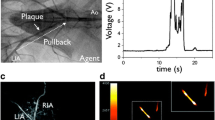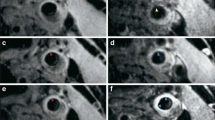Abstract
Angioscopy enables macroscopic pathological diagnosis of cardiovascular diseases from the inside. This imaging modality has been mainly directed to observation of coronary artery diseases. This method is now clinically used for classifying coronary plaques and thrombi, understanding mechanisms of acute coronary syndromes, evaluating percutaneous coronary interventions, evaluating plaque-stabilizing effects of drugs, and recently, for characterizing vulnerable plaques and vulnerable patients and accordingly for prediction of acute coronary syndromes. Fluorescence angioscopy was recently established and is now clinically used for molecular imaging of coronary plaques. Molecular and cellular imaging by this new imaging technology will contribute to more objective evaluation of coronary artery diseases.
Similar content being viewed by others
References and Recommended Reading
Spears JR, Spokojny AM, Marais HJ: Coronary angioscopy during cardiac catheterization. J Am Coll Cardiol 1985, 6:93–97.
Uchida Y, Tomaru T, Nakamura F, et al.: Percutaneous coronary angioscopy in patients with ischemic heart disease. Am Heart J 1987, 114:1216–1222.
Uchida Y: Coronary Angioscopy. New York: Futura Publishing Co. LTD; 2000:79–95.
Uchida Y, Nakamura F, Ohshima T, et al.: Percutaneous fiberoptic angioscopy of the left ventricle in patients with dilated cardiomyopathy and acute myocarditis. Am Heart J 1990, 120:677–687.
Uchida Y: Percutaneous angioscopy of cardiac chambers and valves. In Progress in Cardiology. Edited by Zipes D. Boston, MA: Lea & Febiger; 1991:163–192.
Van Belle E, Ketelers R, Bauters C, et al.: Coronary angioscopic findings in the infarct-related vessel within 1 month of acute myocardial infarction: natural history and the effect of thrombolysis. Circulation 1998, 97:26–33.
Uchida Y, Kanai M, Fujimori Y: Acute coronary syndromes caused by obstruction of the intact stenotic coronary segment by thrombus originating from a small disrupted prestenotic plaque. Circ J 2004, 68(Suppl I):159.
Uchida Y, Yoshinaga K, Kanai M, et al.: Coronary plaques with frosty glass-like surface: a new entity of plaque disruption in acute coronary syndromes. Circ J 2004, 68(Suppl I):116.
Funabashi F, Mizuno K, Kawamura A, et al.: High yellow color intensity by angioscopy with quantitative colorimetry to identify high-risk features in culprit lesions of patients with acute coronary syndromes. Am J Cardiol 2007, 15:1207–1211.
Okada K, Ueda Y, Oyabu J, et al.: Plaque color analysis by the conventional yellow-color grading system and quantitative measurement using LCH color space. J Interv Cardiol 2007, 20:324–334.
Ueda Y, Ohtani T, Shimizu M, et al.: Assessment of plaque vulnerability by angioscopic classification of plaque color. Am Heart J 2004, 148:333–335.
Uchida Y, Fujimori Y, Ohsawa H, et al.: Angioscopic evaluation of stabilizing effects of bezafibrate on coronary plaques in patients with coronary artery disease. Diagn Ther Endosc 2000, 7:21–28.
Uchida Y: Prediction of acute coronary syndromes by percutaneous angioscopy in patients with stable angina. Am Heart J 1995, 130:195–203.
Ohtani T, Ueda Y, Mizoe I, et al.: Number of yellow plaques detected in a coronary artery is associated with future risk of acute coronary syndrome: detection of vulnerable patients by angioscopy. J Am Coll Cardiol 2006, 47:2194–2200.
Uchida Y, Egami H: What determines depth of yellow color of coronary plaques? Proceedings of 20th Annual Meeting of the Japanese Association of Cardioangioscopy. 2005:15.
Uchida Y: Coronary Angioscopy. New York: Futura Publishing Co. LTD; 2000:29–56.
Uchida Y, Nakamura F, Morita T: Observation of atherosclerotic lesions by an intravascular microscope. Am Heart J 1995, 130:1114–1117.
Uchida Y, Uchida Y, Fujimori Y: Endothelial cells covering stent struts are frequently damaged. Circulation 2006, 114(Suppl II):591.
Takano M, Ohba T, Inami S, et al.: Angioscopic differences in neointimal coverage and in persistence of thrombus between sirolimus-eluting stents and bare metal stents after a 6-month implantation. Eur Heart J 2006, 27:2189–2195.
Oyabu J, Ueda Y, Ogasawara N, et al.: Angioscopic evaluation of neointima coverage: sirolimus drug-eluting stent versus bare metal stent. Am Heart J 2006, 152:1168–1174.
Uchida Y, Matsuyama A, Koga A, et al.: Web formation on stent edges: a hitherto unrecognized mechanism of flow disturbance in patients without angiographic in-stent re-stenosis. Circ J 2005, 69(Suppl I):111.
Matsuyama A: Mechanisms of stent edge coronary re-stenosis not detected by angiography. J Jikei Univ 2004, 119:421–427.
Takano M, Mizuno K, Yokoyama S, et al.: Changes in coronary plaque color and morphology by lipid-lowering therapy with atorvastatin: serial evaluation by coronary angioscopy. J Am Coll Cardiol 2003, 42:680–686.
Uchida Y: Medicine for detecting lipid components in vivo and vascular endoscope. US Patent Application Publication US 2006/0062372 A1, 2006.
Uchida Y, Uchida H, Kameda N: Detection of vulnerable coronary plaques by color fluorescent image angioscopy. Circ J 2005, 69(Suppl I):12.
Uchida Y, Maezawa Y, Uchida Y: Molecular imaging of lysophosphatidylcholine (lysoPC) in human coronary plaques by color fluorescence angioscopy. Circ J 2008, 72(Suppl I):191.
Uchida Y, Sakurai T, Koga A: Discrimination of collagen subtypes in the human coronary arterial wall by color fluorescence angioscopy. Proceedings of 40th Japanese Atherosclerotic Society. 2008:20.
Uchida Y, Egami H: Two-dimensional imaging of lipid components in the disrupted coronary plaques by color fluorescence angioscopy. Circ J 2008, 72(Suppl I):427.
Uchida Y, Noike H, Tomaru T, et al.: Two-dimensional imaging of lipids deposited in the coronary plaques by near-infrared fluorescence angioscopy. Circulation 2007, 118(Suppl II):617.
Uchida Y, Noike H, Tomaru T, et al.: Two-dimensional imaging of lipids deposited in coronary plaques during CAG by near-infrared fluorescence angioscopy. Circ J 2008, 72:(Suppl I):50.
Uchida Y: Coronary Angioscopy. New York: Futura Publishing Co. LTD; 2000:201–233.
Kanai M, Sakurai T, Yoshinaga K, et al.: Percutaneous dye-image cardioscopy for detection of endocardial damage. Diagn Ther Endosc 2000, 7:29–34.
Uchida Y, Kanai M, Sakurai T: Visualization of coronary microcirculation by a novel fluorescent image cardioscopy (FIC) in patients with ischemic heart disease. Circ J 2005, 69(Suppl I):435.
Uchida Y, Noike H, Sakurai T: Detection of myocardial microcirculation disturbance by fluorescence cardioscopy in patients with DCM and HCM. Circ J 2008, 72(Suppl I):714.
Uchida Y, Sakurai T, Tomaru T: Real-time imaging of myocardial microcirculation by fluorescence cardioscopy in patients with coronary artery disease who underwent percutaneous coronary interventions (PCI). Circulation 2006, 114(Suppl II):586.
Uchida Y, Fujimori Y, Tomaru T, et al.: Percutaneous angioplasty of chronic obstruction of peripheral arteries by a temperature-controlled Nd-YAG laser system. J Interv Cardiol 1992, 5:301–308.
Uchida Y, Fujimori Y, Hirose J: Percutaneous left ventricular endomyocardial biopsy with angioscopic guidance in patients with dilated cardiomyopathy. Am Heart J 1990, 119:949–952.
Author information
Authors and Affiliations
Corresponding author
Rights and permissions
About this article
Cite this article
Uchida, Y. Coronary angioscopy: From tissue imaging to molecular imaging. curr cardiovasc imaging rep 2, 284–292 (2009). https://doi.org/10.1007/s12410-009-0033-6
Published:
Issue Date:
DOI: https://doi.org/10.1007/s12410-009-0033-6




